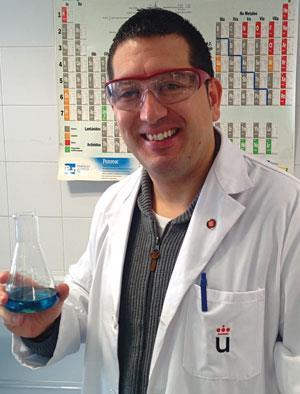
What are you working on at the moment and what is the next big challenge in your field?
Our group tests the anticancer activity of nanostructured materials functionalised with metal complexes. We are trying to find an alternative way to prepare bone fillers to avoid the in situ reproduction of bone tumours after surgery. We know this is an ambitious objective, and completely unaffordable for our group alone, so we are focused on the basic chemistry of this challenge, which is based on the behavioural aspects of these functionalised systems in cancer cells.
Our latest exciting results, obtained in collaboration with other groups, show that these materials are able to protect metal-based drugs and enhance the cellular uptake of the metal complexes. In addition, we have observed that organotin-functionalised mesoporous silica materials are able to abolish tumour growth in syngeneic C57BL/6 mice using non-toxic doses and can also induce apoptosis followed by the development of nonproliferative melanocyte phenotypes in surviving cells. The big challenge in this field is the final application of this kind of material in humans.
Where do you get the inspiration for your research?
I get inspiration from my own life. I had a benign bone tumour – an osteochondroma – in my arm, which kept growing again and again after several operations. I decided to read more about this and I learnt that bone cancers are the tumours most likely to reproduce in the same area, so I decided to focus on this in my science.
What do you enjoy most about your job?
I really love what I do, not only my research work, which is something that fulfils my scientific aspirations, but also teaching. I really love to share my knowledge in chemistry with the undergraduate students and to see them develop their own scientific careers. Supervision of final year project, masters and PhD students is exciting – but also quite exhausting. You can see how the student changes and becomes an independent researcher and know you helped in that process.
Who or what inspired you to become a scientist?
When I was 11 years old my mother passed away. She had breast cancer. From that moment I considered becoming a doctor in oncology.
Later on, before starting my degree, I realised that chemistry is a powerful tool for fighting cancer and I decided to study chemistry, although I was also attracted by physics.
At ChemCYS 2014 you gave a workshop on the art of scientific writing. What are your top tips for putting a research paper together?
It’s difficult to summarise the talk but if I had to choose I would mention these two tips:
1. Structure your thinking by doing a concept sheet of the manuscript before you start writing. This will lead you to have a clear structure of your manuscript and the most important ideas at a glance.
2. Be clear and do not speculate. The best papers are those with an interesting and complex concept, but that are presented with simplicity.
On a more general note, try to read as much science as you can, especially those papers of key authors. This will help you to improve your skills but also help you to develop your own style of writing.
What advice would you give to a young person beginning their career in science?
Take advantage of the different science associations around because they can help you to boost your career by increasing your visibility. In my case, the youth section of the Spanish Royal Society of Chemistry (JIQ-RSEQ) and the European Young Chemists’ Network (EYCN) have been very important in my scientific life. Young chemists can benefit from these associations by attending courses or taking part in educational, research or exchange activities promoted by them. I was really impressed by how many things they do for the next generation of chemists!
When you’re not doing science, what do you enjoy doing?
I really like sports, not only watching, but also practising them. I run marathons – I have already run seven marathons and I hope to finish the eight at the end of April in Madrid. From time to time I also play indoor football. Furthermore, I really love spending time with my wife and our little baby, Sofía.







No comments yet